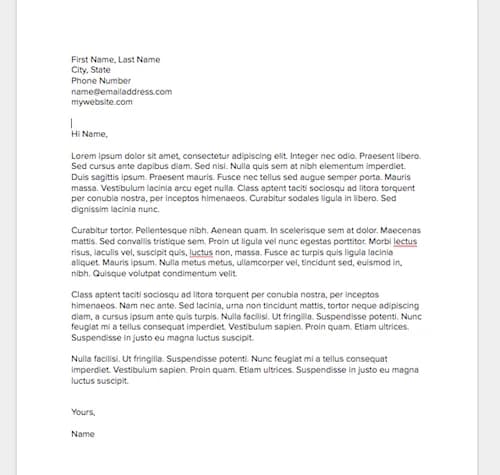The Ultimate Cover Letter Guide
Writing the cover letter to accompany your resume can be intimidating. Plenty of people avoid the task altogether, either by skipping over the jobs that require one, or by trying to apply through LinkedIn or other sites where you can bypass uploading your cover letter. That said, many jobs still require cover letters (and hiring managers often request one even if you sidestepped the process).
That means it's a necessary evil to learn how to write one that does you justice — and makes you memorable. Your cover letter is your chance to tell your story, add context, and introduce yourself to an employer. Think of it this way: Your resume presents you as an objective list of facts and figures, while your cover letter paints a picture.
Cover Letter Definition
A cover letter is a document requested by employers from job applicants. In the cover letter, you as the candidate write about why you would be a good fit for the position. Cover letters are generally one page and range from formal to informal. The objective of a cover letter is to present yourself as the best possible person for the listed job.
The Anatomy of a Good Cover Letter

Every cover letter should include certain elements, such as why you're applying for the job and how your skill set matches the listed requirements. How you ultimately arrange them is up to you, but for the most part, there's a formula and a format (more on that below!). Of course, you'll have to include any specifics listed on the application, such as including a link to your portfolio, sample work, or even testimonials. Some companies will even ask you to include an answer to a character- or personality-driven question (such as what time in history you'd like to visit if you had a time machine — no joke, this question was on an application!) as a way to see if you pay attention to details — as well as verify that you did more than just swap company names out on a stock cover letter.
Format
For the most part, your cover letter should look like a letter. That means a salutation, a few paragraphs and a closing. You'll also need to include your contact information. While the traditional, formal (old school!) advice is to place your address and the company address at the top of the letter, that's not 100% necessary for many modern companies. Of course, you can always err on the side of formality if you're applying to a company that is more traditional.
How to address your cover letter.
First things first: You really have to avoid addressing your cover letter "To Whom May Be Concerned" (or any variation along those lines) or "Dear Company Name." In this day and age, so much information is at your fingertips that can help you get a name. Personalization matters. Think about the junk mail or email you receive that has your name versus a standard, blanket address. While you may not ultimately read or open it, your eyes do notice your name.
When the addressee's name isn't readily apparent, there are a few steps you can take. For starters, try the company's About page, where many organizations list employees. If you know the team the position falls under (such as marketing, or tech), you can address the letter to the director or VP of that team if you can't find a hiring manager on staff. Many small companies (especially startups) don't have HR reps, so finding someone who you think would be your potential boss is the next best thing. (And if you're struggling to find someone's email address, we have tips for that too.)
Another route is through LinkedIn or other networking platforms. Get creative and try at least a few options before giving up. You can also reach out through your connections to see if anyone can point you in the right direction.
How it should look.
Font
Unless you're applying for a graphic designer role, stick with basic fonts. That means Arial, Times New Roman, or any font that's easy to read. Large companies often use applicant tracking systems (ATS) that extract text from your uploaded files (typically your resume and cover letter) and will have issues if you have a non-standard font. Those systems also remove styling. That means if you had bold or italics as a way to draw attention to a certain fact or sentence, you'll want to make sure your emphasis is still apparent without that special styling.
Length
Limit yourself to about three to five paragraphs. For some of you wordier folks, that might seem impossible. However, imagine you're in the hiring manager's role: would you want to read a lengthy, wordy, long cover letter? Think about how we're now more accustomed to shorter paragraphs and plenty of white space due to how we consume content online. Even just the visual effect of a long, dense, text-heavy document can damage your chances of being read.
Address and other info
Let's say you're applying for a job outside your area. A common question is whether including your address will throw off the company. For the most part, it won't. When you apply through an online platform, you generally have to include your personal details in order to submit the application, so that information will be apparent regardless. But if the job posting was clear about wanting local candidates only, your cover letter is the perfect place to explain why you're applying to the job when you live in another state.
How to sign off.
Your cover letter closing can be as simple as, "I'd love to join [company name] as a [position title]. I look forward to chatting with you about this opportunity!" If you want to say more, or less, that's also up to you. As far as the actual closing, "Sincerely," is still perfectly acceptable, as is "Best Regards," or "Best." For almost all candidates, avoid adding a P.S. and other tack-ons, as it'll look overly casual and possibly unprofessional. That said, if you're applying for a job in a creative field, or if you're confident that the company is informal, (which you should be able to pick up from the job description and company content at first glance), go ahead and add some more personality to your letter. As long as you feel confident and comfortable with what you write and your tone, you should be perfectly fine.
What you should say.
Remember that cover letter formula we mentioned earlier? Here it is, plain and simple:
- Your first paragraph should explain who you are in a nutshell. Think of it as your elevator pitch. You want to explain to the reader who you are and what drew you to apply to the position.
- Your second paragraph can either go the safe (and sometimes boring!) route and detail some key, relevant skills, certifications and accomplishments that tie into the posted job description. This is where you include keywords and phrases mentioned under the position's requirements. Your other choice, the bold approach, is to pick a company pain point (which means you really have to dig in with research and make the best guess of what that could be) and describe how you would solve it if you were working for the company.
- The last paragraph wraps everything up and includes answers to any questions mentioned in the application as well as links to your portfolio, if required, or a blurb about how you attached your other required documents (such as references).
Cover Letter Examples
Take a look at these seven cover letter templates that detail everything from what to say when you're changing careers or applying as a new grad, to what to say to a recruiter rather than a direct employer.
Or, take a look at three more cover letter examples from Samantha Shankman, a Fairygodboss contributor and business reporter.
Here's one example to get you started:
Dear ________,
As a former [position], I’m familiar with juggling [key skill mentioned] and [another key skill] as a daily part of the job. In my last position as a [title] I was the
point person for [duties and responsibilities]. I [one to three accomplishments here]. My responsibilities
included [more duties and responsibilities and daily tasks]. My position prior to [first job] consisted of [duties and responsibilities and scope of work]. Additionally, I’ve [more experiences and accomplishments]
point person for [duties and responsibilities]. I [one to three accomplishments here]. My responsibilities
included [more duties and responsibilities and daily tasks]. My position prior to [first job] consisted of [duties and responsibilities and scope of work]. Additionally, I’ve [more experiences and accomplishments]
Most recently, I’ve [current accomplishments, projects, and goals]. Those experiences lead me to believe I'd be the best fit for [position] at [company]. Your company's mission to [summarized mission statement] is one I align with and can support by [solving key company problem within the scope of the position you're apply to]. I'm also well-versed in [any other relevant skills that the job description mentioned].
My portfolio is attached, as requested. I'd love to learn more about your department and discuss with you how I can help.
My portfolio is attached, as requested. I'd love to learn more about your department and discuss with you how I can help.
Sincerely,
(Name)
Do you always need a cover letter?

Actually, no. You don't always need a cover letter. Some companies won't require one (though if it's optional, you should write one!), and some may even expressly state: No cover letters. However, for the most part, the majority of companies will ask for one.
What's the difference between the email you send and a cover letter (are they the same)?
This depends on what type of organization you're sending your application to. For some smaller companies or startups, you may end up writing your email as a cover letter (including all the elements listed above) and attaching your resume. This happens mostly with informal job postings you may find through word of mouth or social media.
In some cases, a job listing doesn't use an online application process and simply requires you to email a resume and cover letter to a listed address. That's when you should write roughly a sentence or two to the recipient and attach your documents to the email without too much ado. You don't want to duplicate what you write in your cover letter, so keep the email short and sweet.
What you should do if you made a mistake in your cover letter?
The job search can feel high stakes, and it's only natural to make a mistake now and again. For instance, let's say you mistakenly left the name of a different company in your repurposed cover letter. In that case, you should rewrite your letter (more than just take out the name) and then reach out to the hiring manager to let them know you have an updated version. Honesty is the best policy here. You can write a short email saying: "Hi [name], Apologies! I sent you the wrong cover letter. Please use the one attached to this email instead. Thank you!"
Internship Cover Letters
For the most part, you'll want to say many of the same things in a cover letter for an internship as one you'd write for a full-time position. However, not everything is the same. For instance, you may not have a relevant work history to share, especially if you're a student or someone transitioning careers. In those circumstances, you'd focus more on what transferable skills you have (either from college classes, student jobs, or prior work history).
Quick Tips Before You Getting Writing
Fairygodboss contributor, career coach and former lawyer Elana Konstant writes:
- Always use keywords from the job description and company media materials in your letter (and resume or CV). If the job description lists specific skills required for the role, be sure to include those same skills in your letter, as long as you’re keeping it honest. A well-written resume should list your skills and accomplishments, and a great cover letter will artfully weave them into a larger story about what your qualifications are, you can bring to the company and the role.
- Have someone (ideally more than one someone) proofread your letter. Proofread it yourself, too — at least three times.
- Check out the employer’s social media feeds to get a sense of the values, culture, and tone for your letter.
- Don't call attention to areas of weakness (e.g., “While I do not have direct [X] experience…”). Instead, spin your background positively, yet accurately.
That's just a sampling of Konstant's knowledge drop. Keep reading for 36 more tips on how to make sure your cover letter is in tip-top shape (No. 40 is key!).
Don’t miss out on articles like these. Sign up!
Why women love us:
- Daily articles on career topics
- Jobs at companies dedicated to hiring more women
- Advice and support from an authentic community
- Events that help you level up in your career
- Free membership, always
